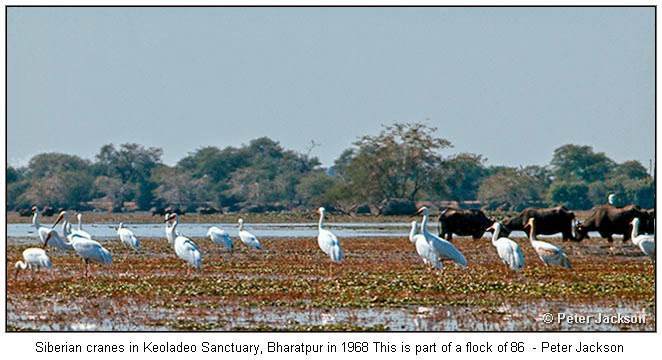The Siberian
crane – Migratory
bird
The Siberian Crane is a very distinctive member of the crane
family with regards to their structure, home ground and behavior. The Siberian
Crane is characterized by white plumage, red or pale yellow eyes, reddish pink
toes or legs. The face and sides of the head are brick red in colour and they
do not have any feathers. It is very difficult to distinguish between the male
and the female. The point of distinction is that the former is larger in size
and have longer beaks. They are omnivorous and eat fishes and insects as well.
The Siberian Cranes nest in western Siberia and migrate to India. The migration
route stretches for 4000 miles. The Siberian Crane is presently an endangered
species. Larger numbers of birds have been hunted over the years.
The Siberian crane / Siberian white crane or the snow crane, is a distinctive among the cranes,
adults are nearly all snowy white, except for their black primary feathers that are visible in flight
and with two breeding populations in the Arctic tundra of western and eastern
Russia. The eastern populations migrate during
winter to China while the western population winters in Iran and formerly, in
India. Among the cranes, they make the longest distance migrations. Their
populations, particularly those in the western range, have declined drastically
in the 20th century due to hunting along their migration routes and habitat
degradation.
Adults of both sexes have a pure white plumage except for the
black primaries, alula and primary coverts.
The forecrown, face and side of head is bare and brick red, the
bill is dark and the legs are pinkish. The iris is yellowish. Juveniles are
feathered on the face and the plumage is dingy brown. There are no elongated
tertial feathers as in some other crane species. During breeding season, both the
male and female cranes are often seen with mud streaking their feathers. They
dip their beaks in mud and smear it on their feathers. The call is very
different from the trumpeting of most cranes and is a goose-like high pitched whistling toyoya. They typically weigh
4.9–8.6 kg (10.8–19 lbs) and stand about 140 cm (55 in)
tall. The wingspan is 210–230 cm (83–91 in) and length is
115–127 cm (45–50 in). Males are on average larger than females.
There is a single record of an outsized male of this species weighing
15 kg (33 lb). The breeding area of the Siberian crane formerly
extended between the Urals and Ob river south to the Ishim and Tobol rivers and east to the Kolyma region. The populations declined
with changes in land use, the draining of wetlands for agricultural expansion
and hunting on their migration routes.
These cranes feed mainly on plants although they are
omnivorous. In the summer grounds they feed on a range of plants including the
roots of hellebore (Veratrum misae), seeds of Empetrum nigrum as well as small rodents (lemmings and
voles), earthworms and fish. They were earlier thought to be predominantly fish
eating on the basis of the serrated edge to their bill, but later studies
suggest that they take animal prey mainly when the vegetation is covered by
snow.
They also swallow pebbles and grit to aid in crushing food in their
crop.
These snow cranes return to the Arctic tundra around the end
of April and beginning of May. The
nest is usually on the edge of lake in boggy ground and is usually surrounded
by water. Most eggs are laid in the first week of June when the tundra is snow
free. The usual clutch is two eggs, which are incubated by the female after the
second egg is laid. The male stands guard nearby. The eggs hatch in about 27 to
29 days. The young birds fledge in about 80 days. Usually only a single chick
survives due to aggression between young birds. The population increase per
year is less than 10%, the lowest recruitment rate among cranes. Their success
in breeding may further be hampered by disturbance from reindeer and sometimes
dogs that accompany reindeer herders. Captive
breeding was achieved by the International Crane Foundation at Baraboo after
numerous failed attempts. Males often killed their mates and captive breeding
was achieved by artificial insemination and the hatching of eggs by other crane
species such as the Sandhill and using floodlights to simulate the longer
daylengths of the Arctic summer.
The
status of this crane is critical and the world population is estimated to be
around 3200–4000, nearly all of them belonging to the eastern breeding
population. Of the 15 crane species this is the most threatened. Historic
records from India suggest a wider winter distribution in the past including
records from Gujarat, near New Delhi and even as far east as Bihar.





a few photos that you have posted for Siberian cranes are actually White storks
ReplyDeleteThe top photograph in your essay is an European White Stork (Ciconia ciconia), not a Siberian Crane (Leucogeranus leucogeranus).
ReplyDeleteDML